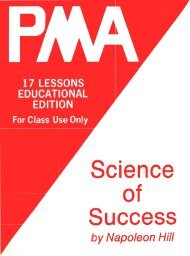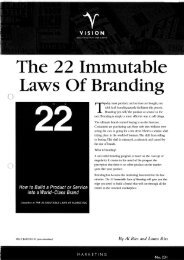The-Slight-Edge
Create successful ePaper yourself
Turn your PDF publications into a flip-book with our unique Google optimized e-Paper software.
148 <strong>The</strong> <strong>Slight</strong> <strong>Edge</strong><br />
Knowing the <strong>Slight</strong> <strong>Edge</strong>, you make the adjustment automatically. You<br />
make those right choices, the ones that serve you. You do those simple, seemingly<br />
insignificant things that forward your progress up the success curve. You read<br />
good books. You listen to motivating tapes. You hang around successful people<br />
who empower you. You’re a five percenter, a winner, a success.<br />
Once you know the <strong>Slight</strong> <strong>Edge</strong>, you know that in getting from point<br />
A to point B you’ll be off track most of the time. And you know that it’s the<br />
adjustments—those little, seemingly insignificant corrections in direction—that<br />
have the most power in your life.<br />
Kaizen: Plan, Do, Review<br />
You know this saying: “Ready ... aim ... ” and what comes next? “Fire!”<br />
right? That’s the way it’s usually put—but there’s a better way.<br />
Ready, fire, aim!<br />
<strong>The</strong> problem with “Ready, aim, fire” is that in the real world, where<br />
everything is in motion and things are constantly changing, by the time you’ve<br />
finished all that readying and aiming, the target is long gone!<br />
Here’s another way of saying ready, fire, aim: plan, do, review.<br />
“Plan, do, review” is an approach to learning that began gaining credibility<br />
in educational institutions toward the end of the twentieth century, and it’s used<br />
in some of the better schools today. It’s a <strong>Slight</strong> <strong>Edge</strong> strategy.<br />
Students plan what they’re going to learn and create their own activities and<br />
experiments for study. <strong>The</strong>n, they do what they planned. And then they review<br />
their planning and doing to see if anything was missing to help them learn what<br />
could be done to improve the process and the results they’ve accomplished. <strong>The</strong>n<br />
they plug those new insights into their next plan, and they’re off and running up<br />
the <strong>Slight</strong> <strong>Edge</strong> curve to success.<br />
<strong>The</strong> operative <strong>Slight</strong> <strong>Edge</strong> strategy at work here is the constant and<br />
consistent back-and-forth of doing actions and correcting those actions—course<br />
correction, just like the moon rocket. What this strategy produces is what<br />
business management philosophy has come to call “continuous improvement,”<br />
a concept that the Japanese call kaizen.<br />
This idea was introduced to Japan after World War II by an American, W.<br />
Edwards Deming. A remarkable statistician, Dr. Deming consulted and lectured<br />
Japanese industrial leaders about “total quality.” He taught that “the system is<br />
the solution”—and showed how it’s always the source of the problem as well.<br />
Remember what happened to the Japanese and American auto industries in<br />
the ’70s and ’80s? <strong>The</strong> Japanese ate America’s lunch in the marketplace. Know<br />
why? <strong>Slight</strong> <strong>Edge</strong> strategy. <strong>The</strong>y had it; we didn’t.













